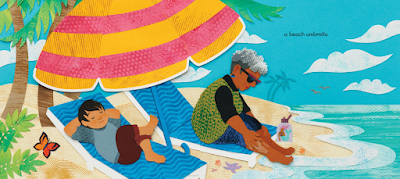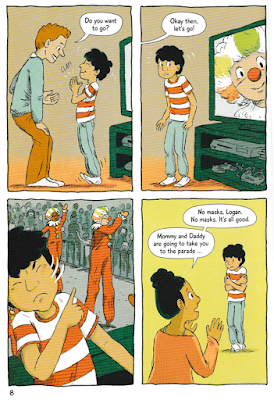Written by Elizabeth MacLeod
Illustrated by Mike Deas
Scholastic Canada
978-1-4431-9612-3
32 pp.
Ages 6–10
May 2023
I can't think of a more accomplished person to highlight during National Indigenous History Month and every month than Buffy Sainte-Marie. Though many know her as a singer-songwriter and young readers may be familiar with her Silver Birch-nominated book Tâpwê and the Magic Hat (2022), this latest illustrated biography from Elizabeth MacLeod and Mike Deas testifies to Buffy Sainte-Marie's varied and good work. |
From Meet Buffy Sainte-Marie by Elizabeth MacLeod, illus. by Mike Deas
|
Buffy Sainte-Marie was probably born in the 1940s on the Piapot First National reserve in Saskatchewan but was taken and adopted by the Sainte-Maries of the northeastern U.S.A. Her childhood, often spent alone, was filled with music, with Buffy starting to play the piano at age 3, and learning music by ear. At 16, she taught herself to play guitar, and, while at university, she started playing at small clubs and then larger ones. After graduation, she became a full-time musician.
 |
| From Meet Buffy Sainte-Marie by Elizabeth MacLeod, illus. by Mike Deas |
As her songs were garnering much attention, from her "Universal Soldier" as a protest song, and "Until It's Time for You to Go" as recorded by countless famous artists, she was noticing how Indigenous roles were depicted on the screen. When she was asked to take a lead rode in an episode of "The Virginian," she maintained the need to hire Indigenous actors for Indigenous roles, leading the action for diversity.
 |
| From Meet Buffy Sainte-Marie by Elizabeth MacLeod, illus. by Mike Deas |
Her other initiatives included starting the Nihewan Foundation for Native American Education which supported Indigenous teens going to university. She has spoken globally about Indigenous Peoples to further understanding. And even though her music was snubbed in the late 1960s and 1970s by radio stations and more for her political messages, she persevered, continuing to extend her activism to championing the rights of Indigenous Peoples. Along the way she won an Oscar, made several important appearances on "Sesame Street," and used new technology for creating visual art and music. She lent her support to the Idle No More movement and was awarded everything from the Polaris Music Prize to Junos and the Spirit of Americana/Free Speech in Music Award.
With her art fuelling her activism, whether it involved Indigenous Peoples, anti-war protests, missing and murdered Indigenous women, or shelter animals, Buffy Sainte-Marie's story in Meet Buffy Sainte-Marie will provide inspiration to young readers. She defies labelling as she is everything from a singer and a songwriter to a humanitarian, a protester, a teacher, a speaker, an advocate, and more. But by letting her heart and passions lead her, she has accomplished so much and done so much good work
Using the power of positivity, Buffy shares her messages with her songs and through art, education and the organizations she supports. Buffy teaches that we can all work together to help make the world a better place. (p. 29)
Elizabeth MacLeod makes sure that readers will learn about Buffy Sainte-Marie's achievements–a timeline of key events appends the illustrated story–but also about her spirit, and her spirit is great, both broad and deep. Buffy uses it, with her voice in music and art, to educate, to mobilize to action, to inspire, and to give voice. Mike Deas's artwork, which involves gouache and watercolour paints and ink, along with digital tools, supports the story with detailed illustrations from Buffy's personal and professional life, from childhood to the 2020s. He takes her story from being taken from her Cree parents as a baby to performing on stage with a red dress–a symbol of missing and murdered Indigenous women. With that, Mike Deas carries readers through nine decades of Buffy Sainte-Marie living and performing and inspiriting.
There are many stirring reads of important Indigenous activists and leaders but, as an illustrated biography, Meet Buffy Sainte-Marie gives us a comprehensive and unequivocal depiction of an amazing woman, a woman of talents, of courage, of conviction and of spirit. The story, as the woman, touches, and impresses.
• • • • • •
Scholastic Canada Biography series by Elizabeth MacLeod and Mike Deas:
Meet Thérèse Casgrain (2021)
Meet David Suzuki (2021)
Meet Buffy Sainte-Marie (2023)















































